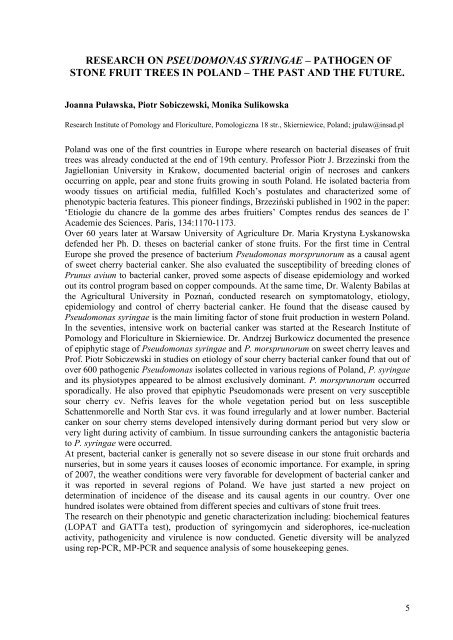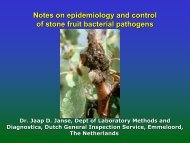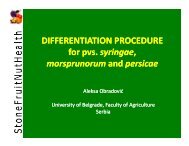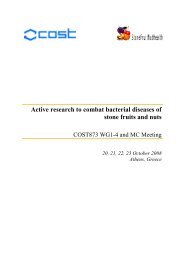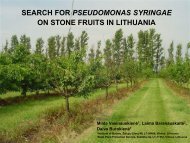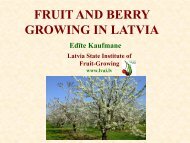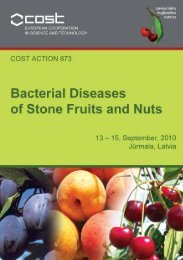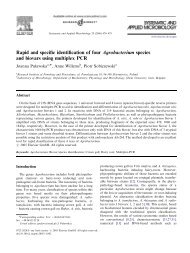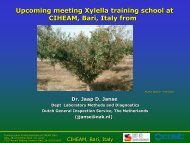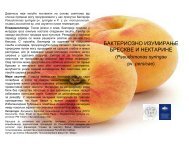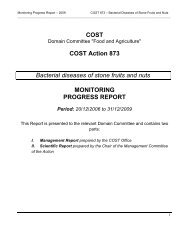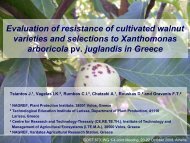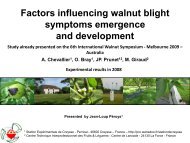Pseudomonas meeting - Cost 873
Pseudomonas meeting - Cost 873
Pseudomonas meeting - Cost 873
- No tags were found...
Create successful ePaper yourself
Turn your PDF publications into a flip-book with our unique Google optimized e-Paper software.
RESEARCH ON PSEUDOMONAS SYRINGAE – PATHOGEN OFSTONE FRUIT TREES IN POLAND – THE PAST AND THE FUTURE.Joanna Puławska, Piotr Sobiczewski, Monika SulikowskaResearch Institute of Pomology and Floriculture, Pomologiczna 18 str., Skierniewice, Poland; jpulaw@insad.plPoland was one of the first countries in Europe where research on bacterial diseases of fruittrees was already conducted at the end of 19th century. Professor Piotr J. Brzezinski from theJagiellonian University in Krakow, documented bacterial origin of necroses and cankersoccurring on apple, pear and stone fruits growing in south Poland. He isolated bacteria fromwoody tissues on artificial media, fulfilled Koch’s postulates and characterized some ofphenotypic bacteria features. This pioneer findings, Brzeziński published in 1902 in the paper:‘Etiologie du chancre de la gomme des arbes fruitiers’ Comptes rendus des seances de l’Academie des Sciences. Paris, 134:1170-1173.Over 60 years later at Warsaw University of Agriculture Dr. Maria Krystyna Łyskanowskadefended her Ph. D. theses on bacterial canker of stone fruits. For the first time in CentralEurope she proved the presence of bacterium <strong>Pseudomonas</strong> morsprunorum as a causal agentof sweet cherry bacterial canker. She also evaluated the susceptibility of breeding clones ofPrunus avium to bacterial canker, proved some aspects of disease epidemiology and workedout its control program based on copper compounds. At the same time, Dr. Walenty Babilas atthe Agricultural University in Poznań, conducted research on symptomatology, etiology,epidemiology and control of cherry bacterial canker. He found that the disease caused by<strong>Pseudomonas</strong> syringae is the main limiting factor of stone fruit production in western Poland.In the seventies, intensive work on bacterial canker was started at the Research Institute ofPomology and Floriculture in Skierniewice. Dr. Andrzej Burkowicz documented the presenceof epiphytic stage of <strong>Pseudomonas</strong> syringae and P. morsprunorum on sweet cherry leaves andProf. Piotr Sobiczewski in studies on etiology of sour cherry bacterial canker found that out ofover 600 pathogenic <strong>Pseudomonas</strong> isolates collected in various regions of Poland, P. syringaeand its physiotypes appeared to be almost exclusively dominant. P. morsprunorum occurredsporadically. He also proved that epiphytic Pseudomonads were present on very susceptiblesour cherry cv. Nefris leaves for the whole vegetation period but on less susceptibleSchattenmorelle and North Star cvs. it was found irregularly and at lower number. Bacterialcanker on sour cherry stems developed intensively during dormant period but very slow orvery light during activity of cambium. In tissue surrounding cankers the antagonistic bacteriato P. syringae were occurred.At present, bacterial canker is generally not so severe disease in our stone fruit orchards andnurseries, but in some years it causes looses of economic importance. For example, in springof 2007, the weather conditions were very favorable for development of bacterial canker andit was reported in several regions of Poland. We have just started a new project ondetermination of incidence of the disease and its causal agents in our country. Over onehundred isolates were obtained from different species and cultivars of stone fruit trees.The research on their phenotypic and genetic characterization including: biochemical features(LOPAT and GATTa test), production of syringomycin and siderophores, ice-nucleationactivity, pathogenicity and virulence is now conducted. Genetic diversity will be analyzedusing rep-PCR, MP-PCR and sequence analysis of some housekeeping genes.5


